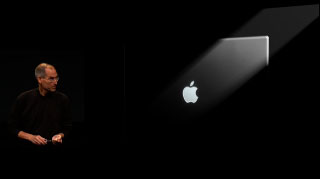
This is the first in a series on Human Brand | defining the inextricable link between people, founding vision and the brands that they produce.
You’ve got to find what you love.
Steve Jobs
There’s passion here for me. Because I can personally relate to Steve Jobs.
Early in my career, I had the chance to work with Steve Jobs. I met him at Stanford, at a conference on design. I followed up, stayed in touch. And we shared stories and ideas. This time frame is the 80s.
There’s a thread to the connection, as well. Lloyd Reynolds. Lloyd was a professor at Reed College. And for both of us, he changed our lives forever. Lloyd infused both of us with a love of typography and the sentience of beauty (calligraphy) in the execution of the written word — and that connection infused the work that I do since that time (the 70s). While Steve dropped out of Reed, he stayed around for the calligraphy classes (see the link above for his commencement speech). Smitten, he was. For Steve’s early technology, typography was an inherent aspect of his expression — his product(s) used type to convey message. And what that message looks like.
Hello!
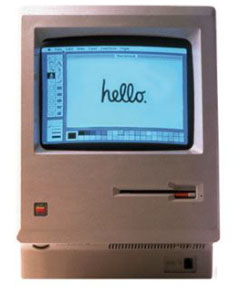
The point is (as has been referenced by Paul Brainerd) and my connection with him, as well, the connection to typography lies at the very heart of computer interface in visible language. The concept is about — if people are reading content, then what does it look like, and how does it work?
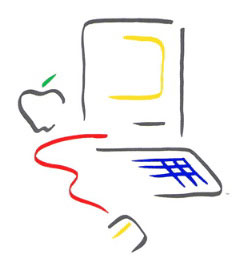
That’s where the connection came, as well as working on the conception of the link between a mouse, cursor device, and the interface of that visualization on screen. What Steve asked for were interpretations of the Mac (MouseActivatedComputer) cursor tool and how fluidly, how fluently, it translated…”my moves” as a draftsman. Or maybe, mouse-man. Beyond that, I worked on creative for Steve on the Macintosh identity and packaging, along with design savant, John Casado, another friend of mine from the design scene in San Francisco, who lead the charge. And created this, along with Tom Hughes.
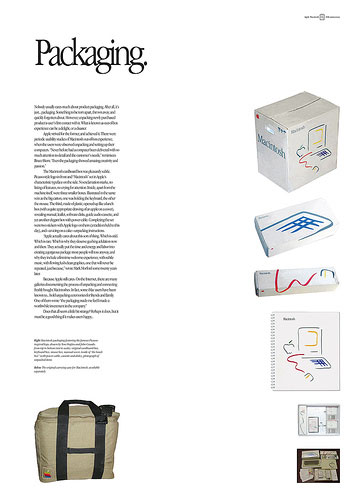
Innovative, then.
From there I — and the Girvin team — worked on the Apple Developers Conference for a couple of years, screen animations, Apple Internet Live! (an early web expression), some industrial design, packaging and merchandising work. Steve left Apple. And then we did some work for Sculley’s team. But we stayed in connection with Steve, too — working for him on Next, and event visualizations.
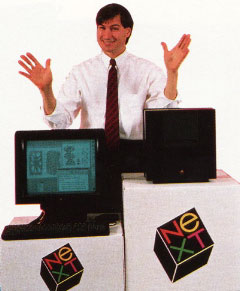
After 30 years, there are some stories — as evinced in the convocation of quotations below — that suggest a certain character with Steve Jobs’ thinking, his presence of mind, on many topics; but there’s a thread. And if you read them, there are insights to add to the exploration. But what this examination and series is really about, for me, is the idea that it is the person that drives the character of the brand, or the collective mind, if there is one, evidenced in team — in fact, there are evincements of that genetic code that can be found densely layered in any organization, where a “person”ality figures in the leadership.
Writing says a lot about strategic intentionality. And Steve Jobs has a lot to say. Here are a grouping of quotes that exemplify his characteristic charisma:
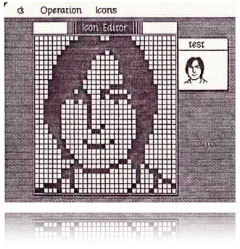
On Innovation and Design:
“It’s rare that you see an artist in his 30s or 40s able to really contribute something amazing.”
— At age 29, in Playboy, February 1985
“I’ve always wanted to own and control the primary technology in everything we do.”
— BusinessWeek Online, Oct. 12, 2004
“Innovation has nothing to do with how many R&D dollars you have. When Apple came up with the Mac, IBM was spending at least 100 times more on R&D. It’s not about money. It’s about the people you have, how you’re led, and how much you get it.”— Fortune, Nov. 9, 1998
“It’s really hard to design products by focus groups. A lot of times, people don’t know what they want until you show it to them.”
— BusinessWeek, May 25 1998
“It comes from saying no to 1,000 things to make sure we don’t get on the wrong track or try to do too much.”
— BusinessWeek Online, Oct. 12, 2004
“(Miele) really thought the process through. They did such a great job designing these washers and dryers. I got more thrill out of them than I have out of any piece of high tech in years.”— Wired magazine, February 1996
On Leaving, Then Returning to — Fix Apple:
“The products suck! There’s no sex in them anymore!”— On Gil Amelio’s lackluster reign, in BusinessWeek, July 1997
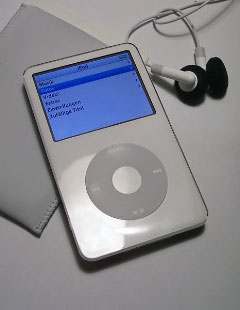
“The cure for Apple is not cost-cutting. The cure for Apple is to innovate its way out of its current predicament.”— Apple Confidential 2.0: The Definitive History of the World’s Most Colorful Company, by Owen W. Linzmayer
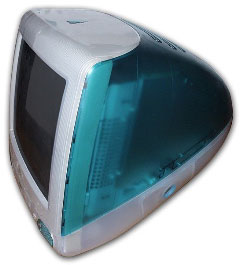
“If I were running Apple, I would milk the Macintosh for all it’s worth — and get busy on the next great thing. The PC wars are over. Done. Microsoft won a long time ago.”— Fortune, Feb. 19, 1996
“You know, I’ve got a plan that could rescue Apple. I can’t say any more than that it’s the perfect product and the perfect strategy for Apple. But nobody there will listen to me.”— Fortune, Sept. 18, 1995
“Apple has some tremendous assets, but I believe without some attention, the company could, could, could — I’m searching for the right word — could, could die.”— On his return as interim CEO, in Time, Aug. 18, 1997
“It wasn’t that Microsoft was so brilliant or clever in copying the Mac, it’s that the Mac was a sitting duck for 10 years. That’s Apple’s problem: Their differentiation evaporated.”— Apple Confidential 2.0
“The desktop computer industry is dead. Innovation has virtually ceased. Microsoft dominates with very little innovation. That’s over. Apple lost. The desktop market has entered the dark ages, and it’s going to be in the dark ages for the next 10 years, or certainly for the rest of this decade.”— Wired magazine, February 1996
“Nobody has tried to swallow us since I’ve been here. I think they are afraid how we would taste.”— Apple shareholder meeting, April 22, 1998
Greatest Sales Lines Ever:
“Do you want to spend the rest of your life selling sugared water or do you want a chance to change the world?”— The line he used to lure John Sculley as Apple’s CEO, according to Odyssey: Pepsi to Apple, by John Sculley and John Byrne
“We made the buttons on the screen look so good you’ll want to lick them.”— Jobs, on Mac OS X’s Aqua user interface (Fortune, Jan. 24, 2000)
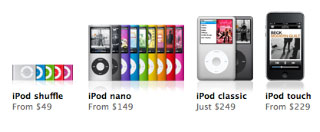
“There are sneakers that cost more than an iPod.”— On the iPod’s $300 price tag, Newsweek, Oct. 27, 2003
“It will go down in history as a turning point for the music industry. This is landmark stuff. I can’t overestimate it!”— On the iTunes Music Store (iTMS), Fortune, May 12, 2003
“What’s new is this amazingly efficient distribution system for stolen property called the internet — and no one’s gonna shut down the internet.”— On how he sold iTMS to the music industry, Rolling Stone, Dec. 3, 2003
“IMac is next year’s computer for $1,299, not last year’s computer for $999.”
— iMac introduction in Cupertino, Calif., May 6, 1998
“The G4 Cube is simply the coolest computer ever. An entirely new class of computer, it marries the Pentium-crushing performance of the Power Mac G4 with the miniaturization, silent operation and elegant desktop design of the iMac. It is an amazing engineering and design feat, and we’re thrilled to finally unveil it to our customers.”— Macworld Expo, July 19, 2000
“It’ll make your jaw drop.”— On the first NeXT Computer, in The New York Times, Nov. 8, 1989
“We believe it’s the biggest advance in animation since Walt Disney started it all with the release of Snow White 50 years ago.”
— On Toy Story, Fortune, Sept. 18, 1995
On Life’s Lessons:
“It’s better to be a pirate than to join the Navy.”
— Odyssey: Pepsi to Apple
“I feel like somebody just punched me in the stomach and knocked all my wind out. I’m only 30 years old and I want to have a chance to continue creating things. I know I’ve got at least one more great computer in me. And Apple is not going to give me a chance to do that.”
— Playboy, September 1987
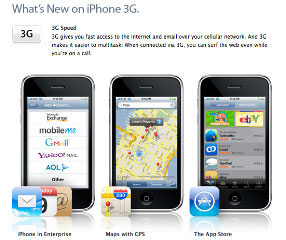
“I’m the only person I know that’s lost a quarter of a billion dollars in one year…. It’s very character-building.”
— Apple Confidential 2.0
Taking the Fight to the Enemy:
“John Sculley ruined Apple and he ruined it by bringing a set of values to the top of Apple which were corrupt and corrupted some of the top people who were there, drove out some of the ones who were not corruptible, and brought in more corrupt ones and paid themselves collectively tens of millions of dollars and cared more about their own glory and wealth than they did about what built Apple in the first place — which was making great computers for people to use.”–The Computerworld Smithsonian Awards Program oral history, April 20, 1995
“It is hard to think that a $2 billion company with 4,300-plus people couldn’t compete with six people in blue jeans.”— On Apple’s lawsuit following his resignation to form NeXT (Newsweek, Sept. 30, 1985)
“My opinion is that the only two computer companies that are software-driven are Apple and NeXT, and I wonder about Apple.”— Fortune, Aug. 26, 1991
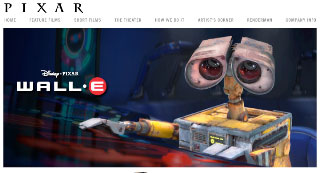
“Why would I ever want to run Disney? Wouldn’t it make more sense just to sell them Pixar and retire?”— Fortune, Feb. 23, 2004
“The subscription model of buying music is bankrupt. I think you could make available the Second Coming in a subscription model and it might not be successful.”— Rolling Stone, Dec. 3, 2003
“The Japanese have hit the shores like dead fish. They’re just like dead fish washing up on the shores.”
— Playboy, February 1985
On Pixar:
“They’re babes in the woods. I think I can help turn Alvy and Ed into businessmen.”— On Pixar co-founders Alvy Ray Smith and Ed Catmull, in Time, Sept. 1, 1986
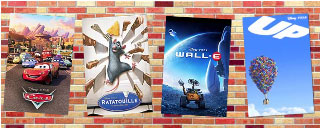
“If I knew in 1986 how much it was going to cost to keep Pixar going, I doubt if I would have bought the company.”
— Fortune, Sept. 18, 1995
“I think Pixar has the opportunity to be the next Disney — not replace Disney — but be the next Disney.”— BusinessWeek, Nov. 23, 1998
Obviously, I like reading this, because the historical span is pretty much the same as my own. My girls learned about computers on the Mac (they’re in their 20s, now) and my offices all thrive on Apple technology. But I like history as well.
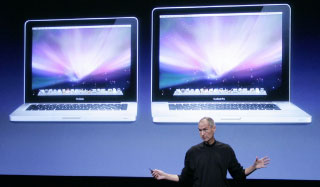
It’s clear that Steve has an opinion — and a style that catalyzes the positioning of Apple. It’s been a legacy of more than 30 years, even including time in which he wasn’t even at Apple. That is inherently the theory that I’d offer to the character of the human brand — is that his particular brand of persona can be sensed in nearly every decision that’s made by the groups that support the legacy of the brand. There are principles in play, that accommodate this conception.
One is simply the person in history.
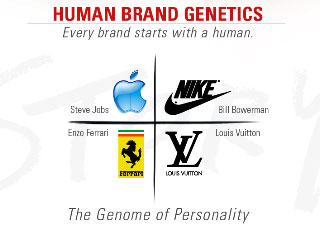
What is the longevity of the spirit of that presence — and how intertwined is that within the power of the brand?
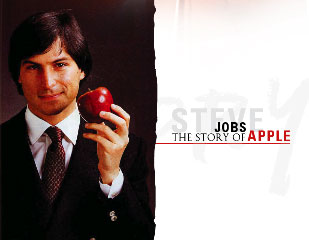
And, in terms of complex media management and disciplined brand expression, there’s no company that quite aligns as comprehensively. Working with him earlier, I found it the case then — and it’s still prevalent now. In fact, in the beginning, he reminds me of this guy:
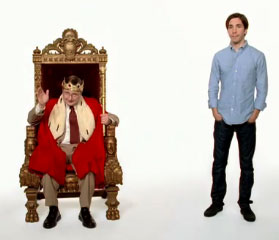
According to Steve, and the leadership team at the October 2008 Special Presentation, it’s all about the story. And people are really all about just that: the story.
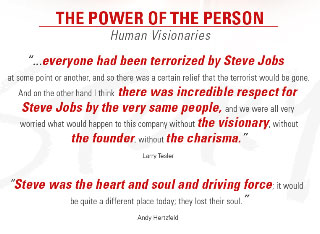
That persona drives a sense of nearly crazy passion that’s become infectious — it’s a principle of leadership that starts on the inside, and ultimately, reflectively, stretches outside. So while there might have been a sense of terror, with Steve Jobs’ tantrums, it more a commitment to doing things exceptionally well, rather than merely the wild ravings of a branding lunatic.
And that passion can be reflective — it goes both ways.
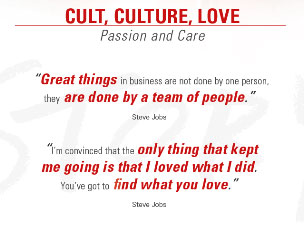
There is a structural breakdown in terms of how this sequencing works, from the heart and opening of the person in the leadership founding sense of the company, and then finally, how is that managed in terms of the spread of actions across the character of the group(s).
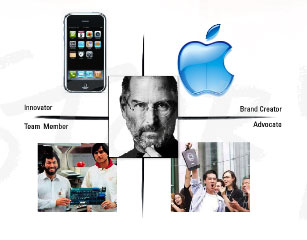
And that’s not only to the experience of the person(s) on the inside, but to the outside, as well.
• Cult & Culture: intimate the very hardwiring of the human brand genetics.
• Story: creating the sensations of captivation of community.
• Premise: establishing the foundation of the brand — what drives it.
• Promise: expresses the definition of the emotional gift.
• Reflection: is the inbound / outbound connection that links between the person and the brand — coming one back, going back another.
Apple does this exceptionally well — and it’s my sense, in the personal connections that I’d had with Steve, that much of that comes from him.
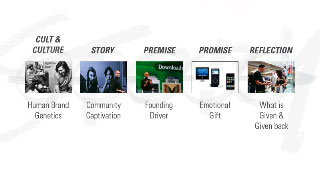
That reflective character created something else — perhaps one of the most profoundly successful attributes of Apple. A brand place. 250 stores. 400,000 people, per day.
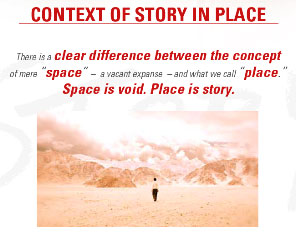
The place of Apple is the Apple Store.
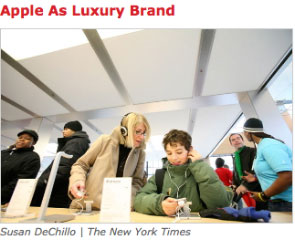
And, as you might explore in the links below, the average Apple Store roughly sells, per square foot, what one might consider the highest end of luxury imaginable.
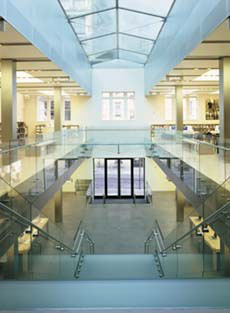
What hearkens back to Steve’s earlier days, his influences at Reed and Professor Reynolds, is the power of aligned design — visible brand language that is framed in the discipline of an array of thinking that is permeable; it’s experienced in everything; there’s a comprehensible experience code that emanates from the story of the person, the brand, the magnetism of the marketing connection.
Who would’ve thought that there would be a branded, solely Apple based computer store (and story, within) 8 years ago. And that they worked? And that they introduced hundreds of thousands of people to the stores, every day (and that many of them, nearly 50%, would be new to Mac).
Every store has its sense of style. But everyone hails to the mission of materials, story and brand resonance. So whether you are in Soho, NYC (above), or Sydney, or Beijing, (below) you’re excited about the experience and connection.
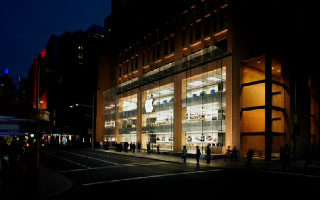

Start young: and that allows for the child to connect (who later retains that reflective connection).
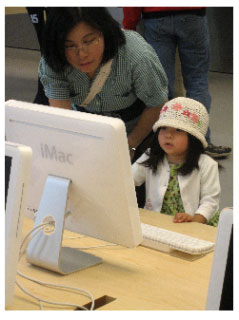
Tell the story: that allows for a distinct character that tells, and sells, the products from the same design linguistics as the products themselves, all of the print, the packaging, the advertising.
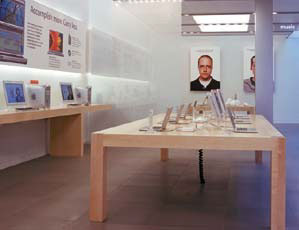
Empower imagining: that power is about imagination in experience: a core facet of Steve Jobs’ personality, his inventive, anarchist strike that relates to entire legacy of his creative spirit, from the very beginning of his leadership.
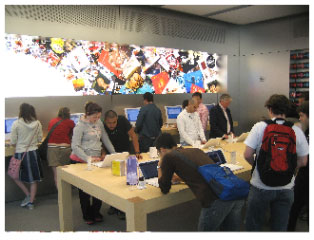
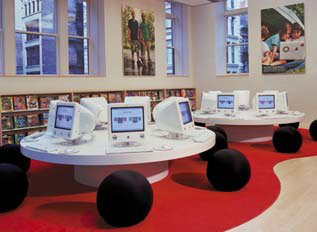
And finally, that’s it — where’s the leader, now?
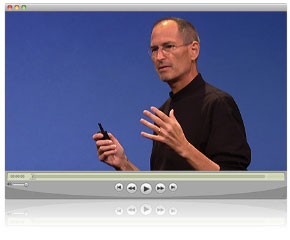
What’s he doing now, that relates to the past? He’s still selling beautiful design enthusiastically. He’s still just as passionate. And he’s still loving what he’s doing.
What’s your take on Steve Jobs?
I’d be interested in hearing your story. Tell me about it.
TSG | Cupertino
References: Owen W. Linzmayer (owenink@owenink.com) is author of Apple Confidential 2.0: The Definitive History of the World’s Most Colorful Company (No Starch Press, 2004, ISBN 1-59327-010-0).
True stories: http://blog.girvin.com/?p=644
Apple as Luxury Brand: http://blog.girvin.com/?p=689